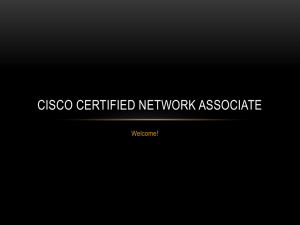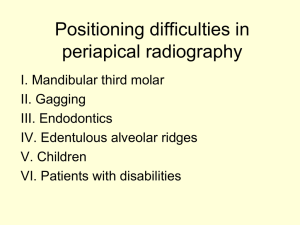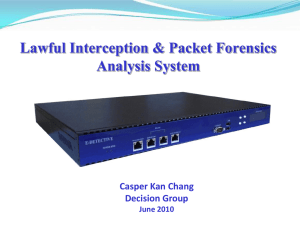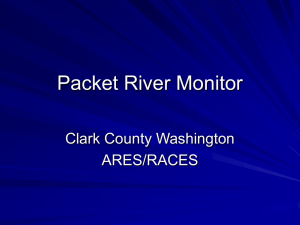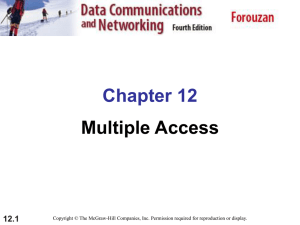lec16
advertisement
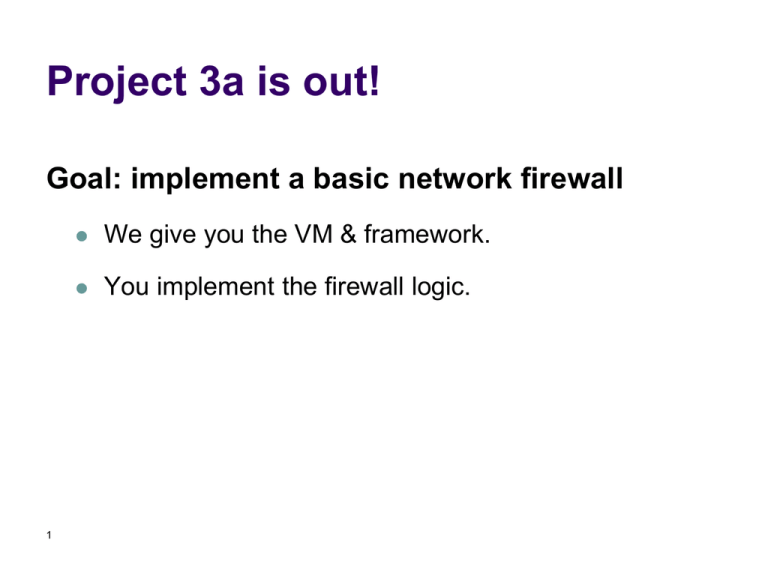
Project 3a is out!
Goal: implement a basic network firewall
1
We give you the VM & framework.
You implement the firewall logic.
Get started early
What Is Firewall?
Blocks malicious traffic
Blocks unauthorized traffic
3
VM
Linux TCP/IP
network stack
ext
firewall
int
1. Decode the packet
2. Check the firewall rules
3. Pass or drop the packet
Packets on wire look like this…
and your firewall should decode this.
5
Firewall rules
Type 1: a combination of
Protocol (TCP/UDP/ICMP)
IP address or country (e.g., Canada)
Port number
Type 2: domain names
6
E.g., block DNS queries for *.facebook.com
NO CHEATING
WE RUN COPY CHECKER
7
Questions?
General questions
Project-specific questions
8
Ask your favorite GSI
Sangjin Han (main)
Steve Wang
Kaifei Chen
Aurojit Panda
DNS and the Web (wrap up)
+
Link Layer
EE 122, Fall 2013
Sylvia Ratnasamy
http://inst.eecs.berkeley.edu/~ee122/
Material thanks to Ion Stoica, Scott Shenker, Jennifer
Rexford, Nick McKeown, and many other colleagues
Announcements (1)
Midterm solutions now posted
We will accept regrade requests received by 5pm, Nov 11
Regrade process if we clearly made a mistake:
Regrade process if you disagree with our assessment
e.g., total is incorrect; correct selection in multiple choice, etc.
Bring it to the attention of your TA/me when you look over your exam
If your TA/I agree, we’ll correct your score immediately
submit a <1-page request, explaining your point
we will regrade your entire exam
process also described on the course webpage
We’ll return your exams after Nov 11
Announcements (2)
Midterm grades
Last Time
Three approaches to improving content delivery
Compensate for TCP’s weaknesses
Caching and replication
Exploit economies of scale
HTTP Performance
Most Web pages have multiple objects
How do you retrieve those objects (naively)?
e.g., HTML file and a bunch of embedded images
One item at a time
New TCP connection per (small) object Slow!
Minimum of 2RTTs per object
Improving HTTP Performance:
Concurrent Requests & Responses
Use multiple connections in
parallel
Connection
setup
HTTP
request
response
R1
T1
R2
T2
R3
T3
Improving HTTP Performance:
Persistent Connections
Maintain TCP connection
across multiple requests (and
even user “sessions”)
Amortize overhead of connection
set-up and tear-down
Allow TCP to learn more accurate
RTT estimate
Allow TCP congestion window to
increase
Default in HTTP/1.1
R1
T1
R2
T2
Improving HTTP Performance:
Pipelined Requests & Responses
Batch requests and responses to
reduce the number of packets
Multiple requests can be
contained in one TCP segment
R1
R2
T1
T2
Scorecard: Getting n Small Objects
Time dominated by latency
One-at-a-time: ~2n RTT
M concurrent: ~2[n/m] RTT
Persistent: ~ (n+1)RTT
Pipelined: ~2 RTT
Pipelined/Persistent: ~2 RTT first time, RTT later
Scorecard: Getting n Large Objects
Time dominated by bandwidth
(F is object size, B is bandwidth)
One-at-a-time: ~ nF/B
M concurrent: ~ [n/m] F/B
assuming shared with large population of users
and each TCP connection gets the same bandwidth
Pipelined and/or persistent: ~ nF/B
The only thing that helps is getting more bandwidth..
Improving HTTP Performance:
Caching
Why
does caching work?
Exploits locality of reference
How
well does caching work?
Very well, up to a limit
Large overlap in content
But many unique requests
Improving HTTP Performance:
Caching: How
Modifier
to GET requests:
If-modified-since – returns “not modified” if
resource not modified since specified time
GET /~ee122/fa13/ HTTP/1.1
Host: inst.eecs.berkeley.edu
User-Agent: Mozilla/4.03
If-modified-since: Sun, 27 Oct 2013 22:25:50 GMT
<CRLF>
Client specifies “if-modified-since” time in request
Server compares this against “last modified” time of resource
Server returns “Not Modified” if resource has not changed
…. or a “OK” with the latest version otherwise
Improving HTTP Performance:
Caching: How
Modifier
to GET requests:
If-modified-since – returns “not modified” if
resource not modified since specified time
Response
header:
Expires – how long it’s safe to cache the resource
No-cache – ignore all caches; always get resource
directly from server
Improving HTTP Performance:
Caching: Where?
Options
Client
Forward proxies
Reverse proxies
Content Distribution Network
Improving HTTP Performance:
Caching: Where?
Baseline: Many clients transfer same information
Generate unnecessary server and network load
Clients experience unnecessary latency
Server
Tier-1 ISP
ISP-1
Clients
ISP-2
Improving HTTP Performance:
Caching with “Reverse Proxies”
Cache documents close to server
decrease server load
Typically done by content provider
Server
Reverse proxies
Backbone ISP
ISP-1
24Clients
ISP-2
Improving HTTP Performance:
Caching with “Forward Proxies”
Cache documents close to clients
reduce network traffic and decrease latency
Typically done by ISPs or enterprises
Server
Reverse proxies
Backbone ISP
Forward
proxies
Clients
ISP-1
ISP-2
Improving HTTP Performance:
Content Distribution Networks
Caching and replication as a service
Large-scale distributed storage infrastructure (usually)
administered by one entity
e.g., Akamai has servers in 20,000+ locations
Combination of (pull) caching and (push) replication
Pull: Direct result of clients’ requests
Push: Expectation of high access rate
Also do some processing
Handle dynamic web pages
Transcoding
Improving HTTP Performance:
CDN Example – Akamai
Akamai creates new domain names for each client
e.g., a128.g.akamai.net for cnn.com
The client content provider modifies its content so that
embedded URLs reference the new domains.
“Akamaize” content
e.g.: http://www.cnn.com/image-of-the-day.gif becomes
http://a128.g.akamai.net/image-of-the-day.gif
Requests now sent to CDN’s (i.e., Akamai’s) infrastructure…
Cost-Effective Content Delivery
Examples:
Web hosting companies
CDNs
Cloud infrastructure
Common theme: multiple sites hosted on shared
physical infrastructure
efficiency of statistical multiplexing
economies of scale (volume pricing, etc.)
amortization of human operator costs
Data Link Layer
(Last Lecture)
Point-to-Point vs. Broadcast Media
Point-to-point: dedicated pairwise communication
E.g., long-distance fiber link
E.g., Point-to-point link between Ethernet switch and host
Broadcast: shared wire or medium
Traditional Ethernet (pre ~2000)
802.11 wireless LAN
(Last Lecture)
Multiple Access Algorithm
Given a shared broadcast channel
Must avoid having multiple nodes speaking at once
Otherwise, collisions lead to garbled data
Need algorithm that determines which node can transmit
Three classes of techniques
Channel partitioning: divide channel into pieces
Taking turns: scheme for trading off who gets to transmit
Random access: allow collisions, and then recover
“Taking Turns” MAC protocols
Polling
Master node “invites” slave
nodes to transmit in turn
data
slaves
poll
master
data
Concerns:
Polling overhead
Latency
Single point of failure (master)
Token passing
• Control token passed from one
node to next sequentially
• Node must have token to send
• Concerns:
– Token overhead
– Latency
– At mercy of any node
None of these are the “Internet way”…
What’s wrong with
TDMA
FDMA
Polling
Token passing
Turn to random access
Optimize for the common case (no collision)
Don’t avoid collisions, just recover from them
Should sound familiar…
Random Access MAC Protocols
Random Access MAC Protocols
When node has packet to send
Two or more transmitting nodes collision
Data lost
Random access MAC protocol specifies:
Transmit at full channel data rate
No a priori coordination among nodes
How to detect collisions
How to recover from collisions
Examples
ALOHA and Slotted ALOHA
CSMA, CSMA/CD, CSMA/CA (wireless, covered later)
Where it all Started: AlohaNet
Norm Abramson left Stanford
in 1970 (so he could surf!)
Set up first data
communication system for
Hawaiian islands
Central hub at U. Hawaii,
Oahu
Aloha Signaling
Two channels: random access, broadcast
Sites send packets to hub (random-access channel)
Hub sends packets to all sites (broadcast channel)
If not received (due to collision), site resends
Sites can receive even if they are also sending
Questions:
When do you resend? Resend with probability p
How does this perform? Need a clean model….
Slotted ALOHA
Model/Assumptions
All frames same size
Time divided into equal
slots (time to transmit a
frame)
Nodes are synchronized
Nodes begin to transmit
frames only at start of
slots
If multiple nodes transmit,
nodes detect collision
Operation
When node gets fresh
data, transmits in next slot
No collision: success!
Collision: node retransmits
with probability p until
success
Slot-by-Slot Example
Efficiency of Slotted Aloha
Suppose N stations have packets to send
Each transmits in slot with probability p
Probability of successful transmission:
by a particular node i: Si = p (1-p)(N-1)
by any of N nodes: S= N p (1-p)(N-1)
What value of p maximizes prob. of success:
For fixed p, S 0 as N increases
But if p = 1/N, then S 1/e = 0.37 as N increases
Max efficiency is only slightly greater than 1/3!
Improving on Slotted Aloha
Fewer wasted slots
Don’t waste full slots on collisions
Need to decrease collisions and empty slots
Need to decrease time to detect collisions
Avoid need for synchronization
Synchronization is hard to achieve
And Aloha performance drops if you don’t have slots!
CSMA (Carrier Sense Multiple Access)
CSMA: listen before transmit
If channel sensed idle: transmit entire frame
If channel sensed busy, defer transmission
Human analogy: don’t interrupt others!
Does this eliminate all collisions?
No, because of nonzero propagation delay
CSMA Collisions
Propagation delay: two
nodes may not hear each
other’s before sending.
Would slots hurt or help?
CSMA reduces but does not
eliminate collisions
Biggest remaining problem?
Collisions still take full slot!
CSMA/CD (Collision Detection)
CSMA/CD: carrier sensing, deferral as in CSMA
Collision detection easy in wired (broadcast) LANs
Collisions detected within short time
Colliding transmissions aborted, reducing wastage
Compare transmitted, received signals
Collision detection difficult in wireless LANs
next lecture
CSMA/CD Collision Detection
B and D can tell that
collision occurred.
Note: for this to work,
need restrictions on
minimum frame size
and maximum
distance.
Why?
Limits on CSMA/CD Network Length
B
A
latency d
Latency depends on physical length of link
Suppose A sends a packet at time t
Time to propagate a packet from one end to the other
And B sees an idle line at a time just before t+d
… so B happily starts transmitting a packet
B detects a collision, and sends jamming signal
But A can’t see collision until t+2d
Limits on CSMA/CD Network Length
B
A
latency d
A needs to wait for time 2d to detect collision
So, A should keep transmitting during this period
… and keep an eye out for a possible collision
Imposes restrictions. E.g., for 10 Mbps Ethernet:
Maximum length of the wire: 2,500 meters
Minimum length of a frame: 512 bits (64 bytes)
512 bits = 51.2 sec (at 10 Mbit/sec)
For light in vacuum, 51.2 sec ≈ 15,000 meters
vs. 5,000 meters “round trip” to wait for collision
What about 10Gbps Ethernet?
Performance of CSMA/CD
Time wasted in collisions
Proportional to distance d
Time spend transmitting a packet
Packet length p divided by bandwidth b
Rough estimate for efficiency (K some constant)
Note:
For large packets, small distances, E ~ 1
As bandwidth increases, E decreases
That is why high-speed LANs are all switched
Recap: Key Ideas of Random Access
1.
Carrier sense
2.
Listen before speaking, and don’t interrupt
Checking if someone else is already sending data
… and waiting till the other node is done
Collision detection
If someone else starts talking at the same time, stop
3.
But make sure everyone knows there was a collision!
Realizing when two nodes are transmitting at once
…by detecting that the data on the wire is garbled
Randomness
Don’t start talking again right away
Waiting for a random time before trying again
Ethernet
Bob Metcalfe, Xerox PARC,
visits Hawaii and gets an idea!
Shared wired medium
coax cable
Evolution
Ethernet was invented as a broadcast technology
Hosts share channel
Each packet received by all attached hosts
CSMA/CD for media access control
Current Ethernets are “switched”
Point-to-point links between switches; between a host and switch
No sharing, no CSMA/CD
(Next lecture) uses “self learning” and “spanning tree” algorithms for
routing
Ethernet: CSMA/CD Protocol
Carrier sense: wait for link to be idle
Collision detection: listen while transmitting
No collision: transmission is complete
Collision: abort transmission & send jam signal
Random access: binary exponential back-off
After collision, wait a random time before trying again
After mth collision, choose K randomly from {0, …, 2m-1}
… and wait for K*512 bit times before trying again
If transmission occurring when ready to send, wait until end of
transmission (CSMA)
Ethernet Frame Structure
Encapsulates IP datagram
Preamble: 7 bytes with a particular pattern used to synchronize
receiver, sender clock rates
Addresses: 6 bytes: frame is received by all adapters on a LAN
and dropped if address does not match
Type: 2 bytes, indicating higher-layer protocol (e.g., IP, Appletalk)
CRC: 4 bytes for error detection
Data payload: maximum 1500 bytes, minimum 46 bytes
MAC Addresses
54
Medium Access Control Address
MAC address
Hierarchical Allocation
Numerical address associated with an adapted
Flat name space of 48 bits (e.g., 00-15-C5-49-04-A9 in HEX)
Unique, hard-coded in the adapter when it is built
Blocks: assigned to vendors (e.g., Dell) by the IEEE
First 24 bits (e.g., 00-15-C5-**-**-**)
Adapter: assigned by the vendor from its block
Last 24 bits
Broadcast address (FF-FF-FF-FF-FF-FF)
Send the frame to all adapters
MAC Address vs. IP Address
MAC addresses (used in link-layer)
Hard-coded in read-only memory when adapter is built
Like a social security number
Flat name space of 48 bits (e.g., 00-0E-9B-6E-49-76)
Portable, and can stay the same as the host moves
Used to get packet between interfaces on same network
IP addresses
Configured, or learned dynamically
Like a postal mailing address
Hierarchical name space of 32 bits (e.g., 12.178.66.9)
Not portable, and depends on where the host is attached
Used to get a packet to destination IP subnet
Two protocols used to bootstrap
communication: DHCP and ARP
Who Am I: Acquiring an IP Address
????
DHCP server
1A-2F-BB-76-09-AD
71-65-F7-2B-08-53
1.2.3.5
0C-C4-11-6F-E3-98
1.2.3.6
• Dynamic Host Configuration Protocol (DHCP)
– Broadcast “I need an IP address, please!”
– Response “You can have IP address 1.2.3.4.”
Who Are You: Discovering the Receiver
71-65-F7-2B-08-53
1.2.3.4
1.2.3.6
1A-2F-BB-76-09-AD
1.2.3.5
0C-C4-11-6F-E3-98
Address Resolution Protocol (ARP)
Broadcast “who has IP address 1.2.3.6?”
Response “0C-C4-11-6F-E3-98 has 1.2.3.6!”
Dynamic Host Configuration Protocol
DHCP configures several aspects of hosts
DHCP server does the allocation
Most important: temporary IP address (lease)
But also: local DNS name server, gateway router, netmask
Multiplexes block of addresses across users
DHCP protocol:
Broadcast (at layer 2) a server-discovery message
Server(s) sends a reply offering an address
host
host ...
host
DHCP server
Response from the DHCP Server
DHCP “offer” message from the server
Informs the client of various configuration parameters (proposed
IP address, mask, gateway router, DNS server, ...)
Lease time (duration the information remains valid)
1.2.3.48 1.2.3.7 1.2.3.156
host
host ...
1.2.3.0/24
255.255.255.0
DNS 1A-2F-BB-76-09-AD
host
host ...
DNS
5.6.7.0/24
1.2.3.19
router
router
router
Response from the DHCP Server
DHCP “offer” message from the server
Multiple servers may respond
Informs the client of various configuration parameters (proposed
IP address, mask, gateway router, DNS server, ...)
Lease time (duration the information remains valid)
Multiple DHCP servers on the same broadcast network
Client accepts one of the offers
Client sends a DHCP “request” echoing the parameters
The DHCP server responds with an “ACK” to confirm
… and the other servers see they were not chosen
Dynamic Host Configuration Protocol
arriving
client
DHCP server
203.1.2.5
Why all the
broadcasts?
DHCP Uses “Soft State”
Soft state: if not refreshed state will be forgotten
Install state with timer, reset timer when refresh arrives
Delete state if refresh not received when timer expires
Allocation of address is “soft state” (renewable lease)
Why does DHCP “lease” addresses?
Host might not release the address
E.g., host crashed, buggy client software
And you don’t want the address to be allocated forever
So if request isn’t refreshed, server takes address back
ARP
Sending Packets Over Link-Layer
1.2.3.53
host
1.2.3.156
host ...
DNS
IP packet
1.2.3.53
1.2.3.156
router
Adapters only understand MAC addresses
Translate the destination IP address to MAC address
Encapsulate the IP packet inside a link-level frame
Address Resolution Protocol
Every node maintains an ARP table
Consult the table when sending a packet
<IP address, MAC address> pair
Map destination IP address to destination MAC address
Encapsulate and transmit the data packet
But: what if IP address not in the table?
Sender broadcasts: “Who has IP address 1.2.3.156?”
Receiver responds: “MAC address 58-23-D7-FA-20-B0”
Sender caches result in its ARP table
What if the destination is remote?
Look up the MAC address of the first hop router
How does the red host know the destination is not local?
1.2.3.48 uses ARP to find MAC address for first-hop router
1.2.3.19 rather than ultimate destination IP address
Uses netmask (discovered via DHCP)
How does the red host know about 1.2.3.19?
Also DHCP
1.2.3.48 1.2.3.7 1.2.3.156
host
host ...
1.2.3.0/24
255.255.255.0
DNS
host
host ...
host
5.6.7.0/24
1.2.3.19
router
router
router
Key Ideas in Both ARP and DHCP
Broadcasting: Can use broadcast to make contact
Caching: remember the past for a while
Scalable because of limited size
Store the information you learn to reduce overhead
Remember your own address & other host’s addresses
Soft state: eventually forget the past
Associate a time-to-live field with the information
… and either refresh or discard the information
Key for robustness in the face of unpredictable change
Taking Stock: Naming
Layer
Examples
Structure
Configuration
App.
Layer
www.cs.berkeley.ed
u
organizational
hierarchy
~ manual
Network
Layer
123.45.6.78
topological
hierarchy
DHCP
Link
layer
45-CC-4E-12-F0-97
vendor
(flat)
hard-coded
Resolution
Service
DNS
ARP
Next Time
Walk through the steps in fetching a web page
End-to-end
Application layer to link layer
With some missing pieces along the way
NAT
Middleboxes
Recap: Steps in reaching a Host
First look up IP address
Need to know where local DNS server is
Search engines + DNS
DHCP
Also needs to know its own IP address
DHCP
Sending a Packet
On same subnet:
On some other subnet:
Need MAC address of destination: ARP
Need MAC address of first-hop router: ARP
Need to tell whether destination is on same or
other subnet?
Use the netmask: DHCP
Example: A Sending a Packet to
B
How does host A send an IP packet to host B?
A
R
1. A sends packet to R.
2. R sends packet to B.
B
Example: A Sending a Packet to
B
How does host A send an IP packet to host B?
A
R
B
Host A Decides to Send Through R
Host A constructs an IP packet to send to B
Source 111.111.111.111, destination 222.222.222.222
Host A has a gateway router R
Used to reach destinations outside of 111.111.111.0/24
Address 111.111.111.110 for R learned via DHCP
A
76
R
B
Host A Sends Packet Through R
Host A learns the MAC address of R’s interface
ARP request: broadcast request for 111.111.111.110
ARP response: R responds with E6-E9-00-17-BB-4B
Host A encapsulates the packet and sends to R
A
77
R
B
R Decides how
to Forward Packet
Two points:
• Routing
table points to this port
Router R’s adapter receives
the packet
• Destination address is within
R extracts the IP packet from the Ethernet frame
mask of port’s address (i.e., local)
R sees the IP packet is destined to 222.222.222.222
Router R consults its forwarding table
Packet matches 222.222.222.0/24 via other adapter
A
78
R
B
R Sends Packet to B
Router R’s learns the MAC address of host B
ARP request: broadcast request for 222.222.222.222
ARP response: B responds with 49-BD-D2-C7-56-2A
Router R encapsulates the packet and sends to B
A
79
R
B

